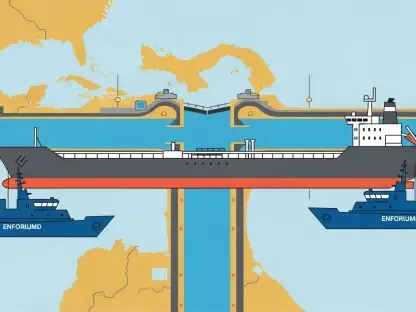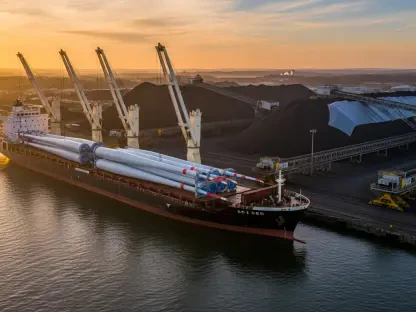Environmental issues remain at the forefront of global concerns, and today we are joined by Christopher Hailstone, an expert in energy management, renewable energy, and grid reliability. In this interview, we delve into the pressing problem of plastic pollution and uncover insights from the latest research on global plastic recycling rates.
What is the current global plastic recycling rate as stated in the study?
The current global plastic recycling rate is under 10 percent, according to the new study. This stagnant rate highlights the ongoing challenges in effectively recycling plastic waste worldwide.
Who conducted the study on global plastic recycling rates?
Researchers from Tsinghua University in China conducted the study. Their comprehensive analysis sheds light on the widespread environmental impact caused by plastic production and waste.
What does the study indicate about the pressing global environmental challenge related to plastic?
The study points to the alarming growth in plastic production, leading to a significant global environmental challenge. This increase in production further exacerbates plastic pollution and poses serious risks to ecosystems and human health.
What are most plastics made from?
Most plastics are made from virgin resin derived from fossil-fuel-based feedstocks.
Why is this concerning in terms of climate change?
This is concerning because the reliance on fossil fuels for plastic production compromises global efforts to mitigate climate change. The production process releases substantial greenhouse gases, contributing to the ongoing climate crisis.
How much plastic was produced in 2022?
In 2022, 437 million tonnes of new plastic were produced.
What percentage of this plastic came from recycled materials?
Only 9 percent of the plastic produced in 2022 came from recycled materials, indicating a minimal impact of recycling efforts on overall plastic production.
Why has the global plastic recycling rate remained stagnant?
The global plastic recycling rate has remained stagnant due to various factors, including the complexity of recycling different types of plastics, contamination issues, and economic challenges. These factors hinder the efficiency of recycling processes and discourage investment in recycling infrastructure.
What is the recycling rate in the US according to the study?
According to the study, the recycling rate in the US is remarkably low at just 5 percent. This is one of the lowest rates globally, despite the country’s high consumption of plastic.
How did China’s 2018 ban on plastic waste imports affect the US recycling rate?
China’s 2018 ban on plastic waste imports significantly worsened the US recycling rate. Prior to the ban, the US exported a large portion of its plastic waste to China for recycling, and the ban disrupted this flow, leading to increased domestic challenges in managing plastic waste.
What is the main destination for plastic waste today?
The main destination for plastic waste today is landfills, accounting for about 40 percent of plastic rubbish.
How has this changed in recent years?
This has shifted in recent years, with an increase in incineration, which now handles 34 percent of plastic waste. This change reflects a move towards waste-to-energy initiatives, especially in regions like Japan, China, and the EU.
Which regions have the highest rates of incinerating plastic waste?
Japan, China, and the EU have the highest rates of incinerating plastic waste. They focus heavily on energy recovery and waste-to-energy initiatives, though this comes with its own environmental risks.
What are some advantages mentioned about waste-to-energy initiatives?
Waste-to-energy initiatives offer advantages such as reducing landfill waste and generating energy from the incineration process. These projects can potentially offset the environmental impact of waste management.
What are the risks associated with burning plastic?
However, burning plastic releases harmful pollutants that require advanced technologies and strict regulations to minimize the environmental and health risks associated with air pollution.
What percentage of the sorted and collected plastic is actually recycled each year?
Despite efforts in sorting and collecting plastic, only about 38 million tonnes of the 75 million tonnes are recycled each year, indicating inefficiencies in the recycling process.
What factors are holding plastic recycling back?
Plastic recycling is held back by factors such as the diversity of plastic materials, contamination from food and labels, and economic obstacles. These issues complicate the recycling process and reduce the viability of recycled plastics.
Why might new (virgin) plastic be cheaper to use compared to recycled plastic?
Virgin plastic can often be cheaper due to fluctuating oil prices, which affect the cost of production. This economic factor discourages the use of recycled plastics and impedes investment in recycling technologies.
What do the researchers suggest could be improved at the design stage?
Researchers suggest that improvements at the design stage, such as creating products that are easier to recycle, can help streamline the recycling process and increase efficiency.
How would this help the recycling process?
Enhanced product design can reduce contamination, simplify sorting, and ultimately improve the quality and amount of plastic that can be recycled, making recycling more effective and economically viable.
How are virgin plastics produced and why is this problematic?
Virgin plastics are produced using fossil-fuel-based feedstocks, contributing to significant greenhouse gas emissions and ecological degradation. This reliance on fossil fuels is a critical issue in addressing both plastic pollution and climate change.
What international efforts are being made to address the issue of plastic pollution?
To tackle plastic pollution, international efforts are underway to negotiate a legally binding treaty on plastics. These negotiations aim to create collaborative frameworks to reduce plastic production and pollution.
Why did the negotiations on a legally binding treaty on plastics fall apart in December?
Negotiations fell apart due to differing interests and priorities among participating countries, making it challenging to reach a consensus on the terms of the treaty.
When are the treaty negotiations expected to resume?
The treaty negotiations are expected to resume in August in Geneva, offering another opportunity for global leaders to address this pressing issue.
How might the research study help the treaty negotiations?
The research study provides a comprehensive overview of the lifecycle of plastic, which can inform and guide successful treaty negotiations, helping to establish effective policies and frameworks for mitigating plastic pollution.
Who is Delphine Lévi Alvarès?
Delphine Lévi Alvarès is the global petrochemicals campaigner manager at the Center for International Environmental Law.
What is her perspective on the study’s findings?
She emphasizes that recycling alone cannot solve the plastic pollution crisis and stresses the importance of reducing virgin plastic production to address environmental and climate challenges effectively.
Do you have any advice for our readers?
My advice is to be conscious of plastic use and seek ways to reduce reliance on single-use plastics. Supporting policies that promote recycling and sustainable practices is crucial. Educating oneself and taking proactive steps in daily life can contribute significantly to mitigating plastic pollution.









